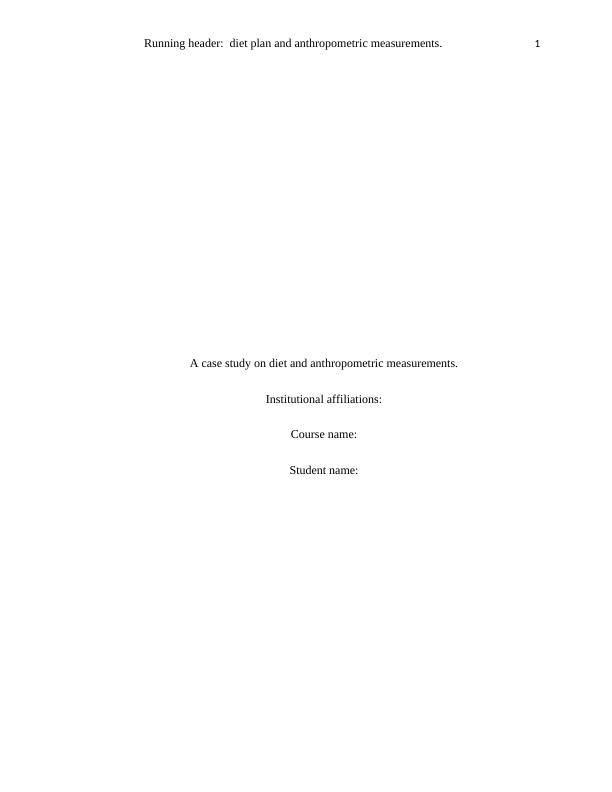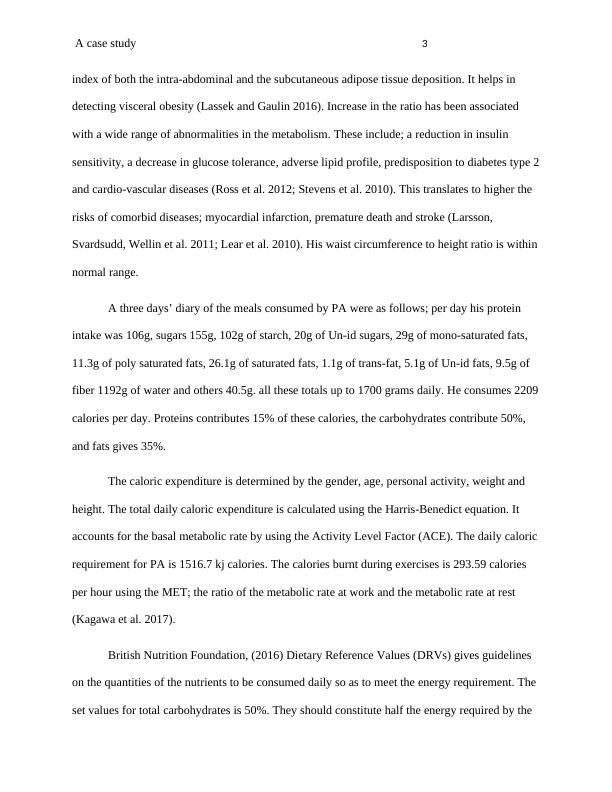Diet Plan and Anthropometric Measurements: A Case Study
Added on 2023-06-13
9 Pages1732 Words395 Views
Running header: diet plan and anthropometric measurements. 1
A case study on diet and anthropometric measurements.
Institutional affiliations:
Course name:
Student name:
A case study on diet and anthropometric measurements.
Institutional affiliations:
Course name:
Student name:

A case study 2
The essay below is a case study on the diet and the anthropometric measurements of an
individual PA who is a 22 years old male. He is 83kgs. His 186 centimeters long. His body mass
index (BMI) is 24. He has a waist circumference of 85 centimeters. His hips circumference is 93
centimeters. The waist to hips ratio is 0.91. He is very active, that is, exercises daily. His diet
comprises of thirty-four types of foods. His total food intake is 5.10kg and per day he takes a
total of 1.70kgs. This paper will; one, analyze his diet for three consecutive days. It involves a
diet diary of his average daily consumption, both the micronutrients and the macronutrients.
Two, calculate his caloric need, energy expenditures and give an interpretation of his
anthropometric measurements Three, analyze if his diet met his caloric needs and also if it was a
balanced diet. Four, give dietary recommendation if there are changes to be met so as to bring
the diet closer to the Dietary Reference Values (DRVs). Five, conclude the case study by
highlighting the key features that were initially observed.
WHO, (2016) anthropometric measures are a tool used to assess the nutritional status of a
person of a certain age and gender. The measures include; weight, height, waist circumference,
hip circumference, fat distribution, the skin fold, the basal metabolic index (BMI) and the waist
circumference to the hips circumference ratio. PA has a weight of 83kgs and is 186 centimeters
long. Using the two parameters his BMI is 24kg/m2. His BMI is within the normal range of 18-
24kg/M2 although it is on the borderline as overweight starts from a BMI of 25kg/m2 (Koch,
Bogado, Araya et al. 2012). His body fat percentage was 12%. The average for a male is 18-24%
although for those who are very active for example the athletes, their average is 6-13. This is an
indication that he is of good weight. His waist circumference is within the normal range of 102
centimeters. The waist to hip circumference ratio is higher than the recommended range in men.
The waist circumference and hip circumference are used to describe fat distribution. It gives an
The essay below is a case study on the diet and the anthropometric measurements of an
individual PA who is a 22 years old male. He is 83kgs. His 186 centimeters long. His body mass
index (BMI) is 24. He has a waist circumference of 85 centimeters. His hips circumference is 93
centimeters. The waist to hips ratio is 0.91. He is very active, that is, exercises daily. His diet
comprises of thirty-four types of foods. His total food intake is 5.10kg and per day he takes a
total of 1.70kgs. This paper will; one, analyze his diet for three consecutive days. It involves a
diet diary of his average daily consumption, both the micronutrients and the macronutrients.
Two, calculate his caloric need, energy expenditures and give an interpretation of his
anthropometric measurements Three, analyze if his diet met his caloric needs and also if it was a
balanced diet. Four, give dietary recommendation if there are changes to be met so as to bring
the diet closer to the Dietary Reference Values (DRVs). Five, conclude the case study by
highlighting the key features that were initially observed.
WHO, (2016) anthropometric measures are a tool used to assess the nutritional status of a
person of a certain age and gender. The measures include; weight, height, waist circumference,
hip circumference, fat distribution, the skin fold, the basal metabolic index (BMI) and the waist
circumference to the hips circumference ratio. PA has a weight of 83kgs and is 186 centimeters
long. Using the two parameters his BMI is 24kg/m2. His BMI is within the normal range of 18-
24kg/M2 although it is on the borderline as overweight starts from a BMI of 25kg/m2 (Koch,
Bogado, Araya et al. 2012). His body fat percentage was 12%. The average for a male is 18-24%
although for those who are very active for example the athletes, their average is 6-13. This is an
indication that he is of good weight. His waist circumference is within the normal range of 102
centimeters. The waist to hip circumference ratio is higher than the recommended range in men.
The waist circumference and hip circumference are used to describe fat distribution. It gives an

A case study 3
index of both the intra-abdominal and the subcutaneous adipose tissue deposition. It helps in
detecting visceral obesity (Lassek and Gaulin 2016). Increase in the ratio has been associated
with a wide range of abnormalities in the metabolism. These include; a reduction in insulin
sensitivity, a decrease in glucose tolerance, adverse lipid profile, predisposition to diabetes type 2
and cardio-vascular diseases (Ross et al. 2012; Stevens et al. 2010). This translates to higher the
risks of comorbid diseases; myocardial infarction, premature death and stroke (Larsson,
Svardsudd, Wellin et al. 2011; Lear et al. 2010). His waist circumference to height ratio is within
normal range.
A three days’ diary of the meals consumed by PA were as follows; per day his protein
intake was 106g, sugars 155g, 102g of starch, 20g of Un-id sugars, 29g of mono-saturated fats,
11.3g of poly saturated fats, 26.1g of saturated fats, 1.1g of trans-fat, 5.1g of Un-id fats, 9.5g of
fiber 1192g of water and others 40.5g. all these totals up to 1700 grams daily. He consumes 2209
calories per day. Proteins contributes 15% of these calories, the carbohydrates contribute 50%,
and fats gives 35%.
The caloric expenditure is determined by the gender, age, personal activity, weight and
height. The total daily caloric expenditure is calculated using the Harris-Benedict equation. It
accounts for the basal metabolic rate by using the Activity Level Factor (ACE). The daily caloric
requirement for PA is 1516.7 kj calories. The calories burnt during exercises is 293.59 calories
per hour using the MET; the ratio of the metabolic rate at work and the metabolic rate at rest
(Kagawa et al. 2017).
British Nutrition Foundation, (2016) Dietary Reference Values (DRVs) gives guidelines
on the quantities of the nutrients to be consumed daily so as to meet the energy requirement. The
set values for total carbohydrates is 50%. They should constitute half the energy required by the
index of both the intra-abdominal and the subcutaneous adipose tissue deposition. It helps in
detecting visceral obesity (Lassek and Gaulin 2016). Increase in the ratio has been associated
with a wide range of abnormalities in the metabolism. These include; a reduction in insulin
sensitivity, a decrease in glucose tolerance, adverse lipid profile, predisposition to diabetes type 2
and cardio-vascular diseases (Ross et al. 2012; Stevens et al. 2010). This translates to higher the
risks of comorbid diseases; myocardial infarction, premature death and stroke (Larsson,
Svardsudd, Wellin et al. 2011; Lear et al. 2010). His waist circumference to height ratio is within
normal range.
A three days’ diary of the meals consumed by PA were as follows; per day his protein
intake was 106g, sugars 155g, 102g of starch, 20g of Un-id sugars, 29g of mono-saturated fats,
11.3g of poly saturated fats, 26.1g of saturated fats, 1.1g of trans-fat, 5.1g of Un-id fats, 9.5g of
fiber 1192g of water and others 40.5g. all these totals up to 1700 grams daily. He consumes 2209
calories per day. Proteins contributes 15% of these calories, the carbohydrates contribute 50%,
and fats gives 35%.
The caloric expenditure is determined by the gender, age, personal activity, weight and
height. The total daily caloric expenditure is calculated using the Harris-Benedict equation. It
accounts for the basal metabolic rate by using the Activity Level Factor (ACE). The daily caloric
requirement for PA is 1516.7 kj calories. The calories burnt during exercises is 293.59 calories
per hour using the MET; the ratio of the metabolic rate at work and the metabolic rate at rest
(Kagawa et al. 2017).
British Nutrition Foundation, (2016) Dietary Reference Values (DRVs) gives guidelines
on the quantities of the nutrients to be consumed daily so as to meet the energy requirement. The
set values for total carbohydrates is 50%. They should constitute half the energy required by the

End of preview
Want to access all the pages? Upload your documents or become a member.
Related Documents
Dietary Planning Across the Lifespan Research Paper 2022lg...
|23
|3543
|51
Weight Management in Health and Disease: A Case Study Analysislg...
|10
|2686
|366
Body Composition Analysis Practicallg...
|16
|2665
|109
Weight Loss Programme for Optimal Body Compositionlg...
|13
|4700
|76
Fitness Testing and Exercise Recommendations for Client 1lg...
|6
|1456
|93
Evaluation and Treatment of Childhood Obesitylg...
|2
|640
|18
